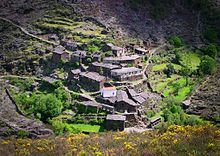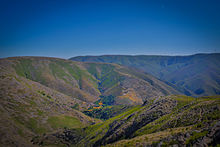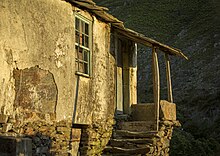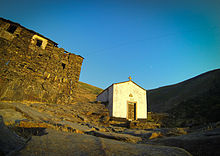Drave (Portugal)
| Drave | ||||||
|---|---|---|---|---|---|---|
|
||||||
| Basic data | ||||||
| Region : | Norte | |||||
| Sub-region : | Porto metropolitan area | |||||
| District : | Aveiro | |||||
| Concelho : | Arouca | |||||
| Freguesia : | União das Freguesias de Covelo de Paivó e Janarde | |||||
| Coordinates : | 40 ° 52 ′ N , 8 ° 7 ′ W | |||||
| politics | ||||||
| Website: | www.drave.cne-escutismo.pt | |||||
Drave [ 'dɾavə ] is an abandoned village in Portugal . It belonged to the former municipality ( Freguesia ) Covelo de Paivó in the district ( Concelho ) of Arouca in the Aveiro district .
Drave is located in the Geoparque de Arouca , a geopark of the worldwide UNESCO program. The village has been looked after by the Portuguese scouts since 2000 , who do not have a permanent presence here, but come several times a year for activities and get-togethers or guide visitors.
Drave was also known under the nickname "magical village" ( Portuguese : Aldeia mágica ), as visitors often describe the impression that the completely uninhabited village with its old houses and ruins and its wide views of the valley and surrounding mountain ranges gives as magical .
Drave shows no sign of modernity and is not accessible by car. The village is not connected to electricity or water supply, neither to the sewer system nor to the Internet, and has only very limited radio and mobile phone network reception. The fact that money is useless here due to the lack of shops or vending machines is also often mentioned by visitors as a hallmark of the village.
geography
Drave is difficult to access on a high rock ledge between the rocky and sparsely vegetated mountain ranges of Serra da Freita (1,085 meters), Serra de São Macário (1,052 meters) and Serra da Arada (1,071 meters). The village is between 606 and 652 meters high and offers wide views of the valley and the surrounding mountain ranges.
A torrent flows through the village.
history
Drave is documented for the first time in documents from the 14th century, during the reign of King D. Dinis .
In the royal registers of 1527 it is listed as one of three villages in the municipality of São Martinho das Moitas and had eight inhabitants.
The records of 1758 record Drave as a place of the municipality Covelo de Paivó in the county of Lafões , with 22 inhabitants.
At the beginning of the 18th century, Francisco Martins moved with his wife Maria Martins to Drave and built the only two-story house, called Solar dos Martins , with its striking veranda and a small wine cellar extension. The Martins family organized their first family reunion here in 1946, for which around 500 family members came together.
The village lived on agriculture and animal husbandry, especially cattle and goats. The surrounding mines provided additional work, in particular the tungsten deposits were in high demand during the Second World War .
The village, cut off from all progress, lost more and more residents who emigrated to the cities or abroad due to the increasingly difficult living conditions as a result of the economic changes, especially since the 1960s. The last time a child was born in Drave was in 1971.
Drave first became the target of scientific research in 1989, when a group of Portuguese students of social sciences examined the phenomenon of rural exodus and the increasing number of abandoned villages in the Portuguese hinterland using the example of Draves.
In 1992 a Portuguese scout group came for the first time to camp in Drave and to carry out the first conservation measures.
In 1993 a solar-powered telephone and power supply was set up for the last two residents (in operation until 2000).
In 1995, the Portuguese scout umbrella organization Corpo Nacional de Escutas acquired some buildings in order to set up a base camp here in the future (opening in 2003).
An application for the inclusion of Drave in the Portuguese list of monuments SIPA was made for the first time in 1996, since 2012 the village is listed .
With Joaquim Martins, the last resident left the place in 2000.
Drave has been the victim of light, occasionally serious vandalism several times , the most serious in 2008, when young people set three houses here, some of them on fire. The incident was mentioned nationwide.
In 2009 the Arouca Geopark was added to the Global Network of UNESCO Geoparks . Drave is part of the geopark.
In 2014 the highly acclaimed documentary Uma Montanha do Tamanho do Homem about the village of Drave was released.
Sights and culture
The village is worth seeing because of its location, its stone and slate houses and the local watercourse with a small waterfall. The small chapel Capela de Nossa Senhora da Saúde , built in 1851, is the only whitewashed building in the village, all other houses are dark because of the untreated walls and roofs made of regional stone and slate (with one exception with a roughly plastered facade).
Visitors name the wide views, the silence and the natural experience as major attractions of the village.
The village as a whole has been a listed building since 2012 .
Drave is a popular destination for hikers. The 4 km long Portuguese short hiking trail PR 14-ARC leads through Drave and bears the thematic name "A Aldeia Mágica".
The village and its surroundings are also popular with mountain bikers , mountaineers and climbers .
Every year on August 15, the Festa da Nossa Senhora da Saúde takes place here, to which former villagers and their families, but also residents of surrounding villages and other visitors come. The religious festival, which takes place on the Assumption of Mary and serves the devotion of Mary to the patron saint Our Lady of Sorrows (Portuguese: Nossa Senhora da Saúde ), is characterized by processions, church services and a part similar to a folk festival .
The second annual village festival, the Festa dos Brasileiros on September 8th, has not taken place since the 1980s.
reception

The village was often portrayed on Portuguese television, particularly in reports by the public RTP , but also on private channels.
Several books have been published about the village, which has also featured in songs by Portuguese pop and rock bands, including pieces by the groups Flor-de-Lis and Se7e named after the village .
In 2014 the documentary Uma Montanha do Tamanho do Homem by the Portuguese director João Nuno Brochado was released , which portrays the village. The first edition of the DVD / Blu-ray double edition was the top seller of the Portuguese retail market leader Fnac for several weeks and sold out quickly. A second edition followed in March 2015, and the film has been out of print since then.
literature
- Claúdia C. Silva, Eugénia C. Almeida, Maria Júlia Morais, Maria Madalena Soares: Antropologia e Realidade Portuguesa. Drave: um passado sem futuro? , 1989
- Drave: O rosto das Palavras. , Photos by Rui de Carvalho and poems by Maria José Castro , 2001
- João Nepomuceno de Almeida Martins: Monografia e árvore genealógica dos Martins da Drave. , 1996
- Flora e Fauna - Drave , Corpo Nacional de Escutas 2013
- Supplement of the DVD / BluRay edition Uma Montanha do Tamanho do Homem , Cimbalino Filmes 2014
Web links
- Website of the Scout Base Drave (Eng. And Port.)
- Drave - Uma Montanha do Tamanho do Homem , Official website for the documentary
- Entry of the village Drave in the Portuguese list of monuments SIPA
Individual evidence
- ↑ a b Entry of Aldeia de Drave in the Portuguese list of monuments SIPA, accessed on April 23, 2017
- ↑ Statements and information in the documentary Drave - Uma Montanha do Tamanho do Homem and in the supplement to the 2nd edition (March 2015) of the DVD / BluRay edition, Cimbalino Films
- ↑ Recording of the TV report in the SIC news program , recording on YouTube, accessed on April 23, 2017
- ↑ The PR14-ARC hiking trail, video impressions with music on YouTube , accessed on April 23, 2017
- ↑ Reportage Aldeia Escutista (2007) by the SIC station , recorded on YouTube, accessed on April 23, 2017






